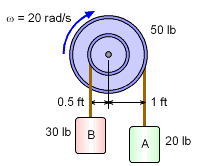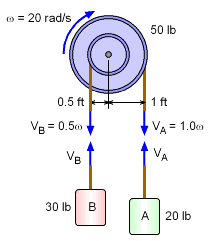| Ch 7. Rigid Body Energy Methods | Multimedia Engineering Dynamics | ||||||
| Rot. Work & Energy | Conservation of Energy | ||||||
| Rotational Kinetic Energy and Work | Case Intro | Theory | Case Solution | Example |
| Chapter |
| - Particle - |
| 1. General Motion |
| 2. Force & Accel. |
| 3. Energy |
| 4. Momentum |
| - Rigid Body - |
| 5. General Motion |
| 6. Force & Accel. |
| 7. Energy |
| 8. Momentum |
| 9. 3-D Motion |
| 10. Vibrations |
| Appendix |
| Basic Math |
| Units |
| Basic Dynamics Eqs |
| Sections |
| eBooks |
| Dynamics |
| Fluids |
| Math |
| Mechanics |
| Statics |
| Thermodynamics |
| ©Kurt Gramoll |
|
|
||
 Pulley with Two Weights |
Example |
|
|
A 50 lb pulley has two weights, A and B, attached at different distances from the center. If the pulley has an angular velocity of 20 rad/s, what is the total kinetic energy of the whole system? Assume the radius of gyration of the pulley is 0.6 ft. |
||
| Solution |
||
|
|
The total kinetic energy is the sum of the kinetic energy of each of the three parts. 1. Kinetic energy of the pulley: 2. Kinetic energy of mass A 3. Kinetic energy of mass B T = T1 + TA + TB = 111.8 + 124.2 + 46.59 T = 282.6 ft lb |
|
